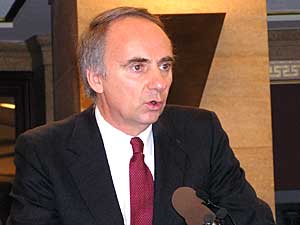Audio
Photos
More from MPR
Resources
Respond to this story
| |||||||||||||||||||||||||||||||||||
State faces $700 million budget shortfall
December 1, 2004
Minnesota's fiscal woes aren't over. State officials said on Wednesday that Minnesota faces a projected $700 million deficit for the next two-year budget cycle. Lawmakers already erased a projected $4.5 billion deficit in the current budget. Gov. Pawlenty says even though the size of the problem has grown from earlier projections, he still plans to cover the shortfall without raising taxes.
St. Paul, Minn. — State finance officials say the state's revenues are projected to go up about 3 percent in the budget cycle that starts next July. They say the problem is that spending - particularly on health care - is going up much more than that.
 | |||
State economist Tom Stinson says Minnesota's economy is growing. But he says the state won't grow its way out of its fiscal problems.
"We had probably if not the strongest growth in 20 years, almost the strongest growth in 20 years this year and you saw that we didn't grow our way out of it. So this is a structural problem," Stinson said.
In other words, if you plot the state's revenues and expenses on a graph over the next several years, the revenue line will always be below the expense line. That is, unless you change the structure of the state's finances.
Commissoner of Finance Peggy Ingison says the problem can be solved with either more revenue or less spending. Gov. Pawlenty says the answer is slowing down spending growth. He says health and human services spending is expected to increase 20 percent in the next biennium.
 | |||
"The health and human services portion of the Minnesota state budget is rising at a pace that is out of control. There's no simple or better way to say it than that," he said.
State officials say most of the projected increase comes from state programs that provide basic health care to low-income families and children.
Pawlenty says the proposed budget he releases in January will rein in health care spending to a more manageable increase, while also putting more money into education. He didn't say how he plans to do that, but says there's no need to raise taxes to balance the budget, since Minnesota's revenues are going up.
|
The bottom line is there's been very little change in the
state's revenues. It could be better in February or it could be worse in February, when we do this again.
- State economist Tom Stinson |
DFL legislative leaders aren't calling for a tax increase, but they were quick to paint a bleak picture of the state's options. Senate Majority Leader Dean Johnson of Willmar says lawmakers already used up the easy solutions when they erased the multi-billion-dollar deficit in the current budget.
"Any use of shifts, accounting gimmicks, anything that were used in the past, the one-time monies - the well is dry. There is no more," Johnson said.
Johnson says Democrats want to adequately fund education, health care and transportation. He says they're also concerned that state cuts in local government aid have resulted in higher property taxes.
DFL leaders also point out the state's current accounting methods mask a potentially larger problem. They say the size of the projected deficit doubles to $1.4 billion if inflation is taken into account.
House Republican leaders had a much rosier view of the state's finances. Ways and Means Committee Chairman Jim Knoblach, R-St. Cloud, notes that the state actually has a surplus in the current budget cycle.
"Generally speaking, this is good news. We've got $500 million more this year than we expected to have, we've got $226 million more in the health care access fund, if you just added those two in, you wouldn't have a deficit at all," he said.
But the extra money in the current budget - nearly $500 million dollars - won't reduce the projected deficit. It will automatically go to build up the state's budget reserves and cash flow account. When that happens, the state will have about a billion dollars in cash reserves.
 | |||
Finance Commissioner Ingison says tapping into those reserves to balance the budget would be fiscally irresponsible. She says the bond rating agencies will be watching Minnesota to see how it handles this deficit.
"We've used these one-time items, we've begun to build the reserves back up, now it's kind of a critical point at which how we react to this information in setting the budget now," she said.
One rating agency - Moody's - has already downgraded Minnesota from its AAA bond rating. The top rating allowed Minnesota to borrow money at the lowest rates.
Gov. Pawlenty and lawmakers will use the new forecast to begin budget planning, but the final budget will be based on another economic forecast due in February.
|
News Headlines
|
Related Subjects
|


